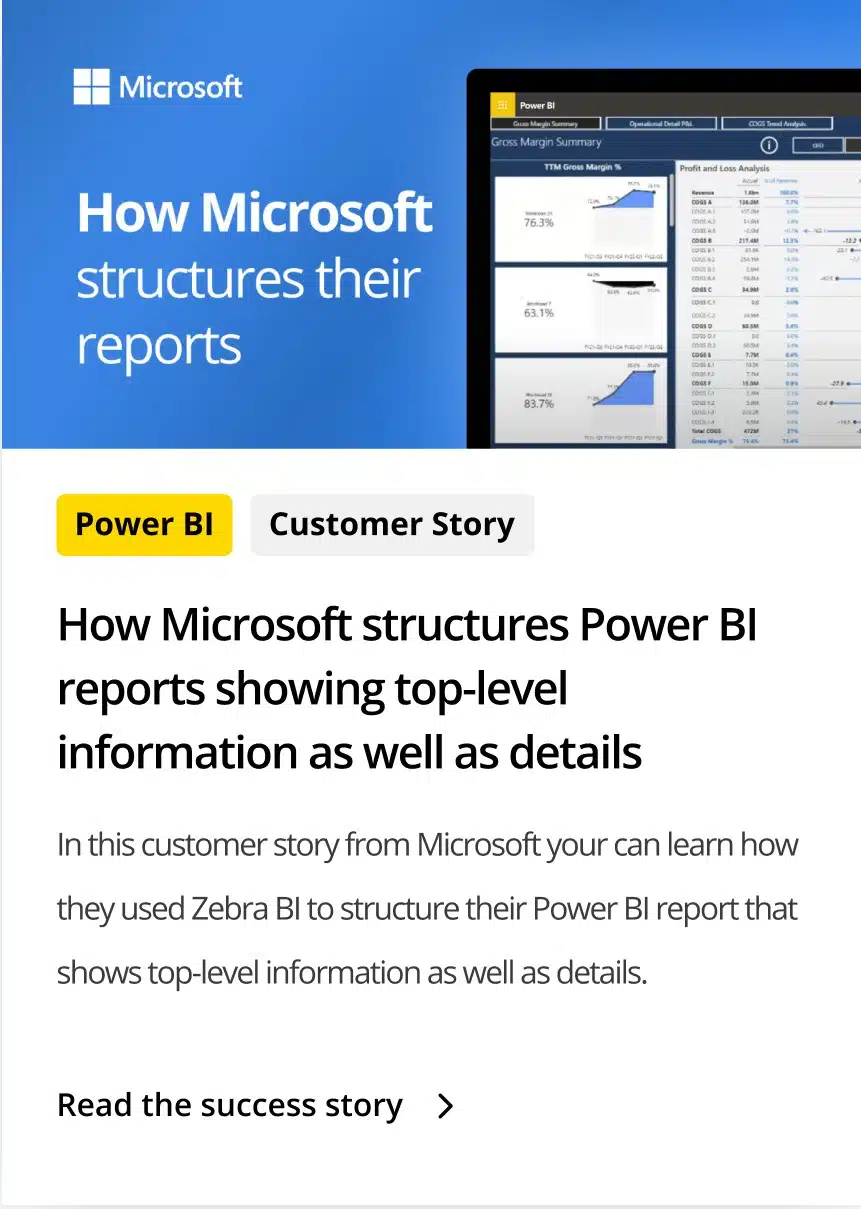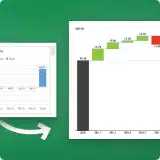If you want to create a visually appealing and informative data visualization in Power BI, ribbon charts are a great option to consider. These charts are an effective tool for displaying categorical data, and their distinctive design can help highlight trends and patterns in your data. In this article, we’ll walk you through the steps of creating a ribbon chart in Power BI, as well as provide tips and tricks for customizing and analyzing your chart. Let’s get started!
Table of Contents
Understanding the Basics of Power BI Ribbon Charts
Before we dive into creating a ribbon chart, let’s take a moment to familiarize ourselves with the basics. A ribbon chart, also known as a parallel coordinates chart, is a type of chart that displays multiple dimensions of data. Each vertical axis represents a separate dimension or category, with the horizontal lines connecting data points across the axes. The thickness of these lines represents the relative density of the data points at that particular location in the chart. This design makes it easy to identify relationships between variables, and to spot trends or outliers in your data.
One of the key benefits of using ribbon charts in Power BI is the ability to filter and highlight specific data points. By selecting a particular line or category on the chart, you can filter the data to show only the relevant information. Additionally, you can use color coding or other visual cues to highlight important data points or trends. This makes it easy to communicate insights and findings to others, and to make data-driven decisions based on your analysis.
Why You Should Use Ribbon Charts in Your Data Visualizations
Ribbon charts are a great choice for any data visualization where you want to display multiple dimensions of data in a visually appealing and efficient way. They can be especially useful for analyzing trends over time or for identifying outliers in your data. Additionally, ribbon charts are highly customizable, which means that you can tailor them to suit your specific needs or personal style.
Another advantage of using ribbon charts is that they can help you to easily compare data across different categories or groups. By using different colors or shades within the ribbon, you can quickly see how different segments of your data are performing relative to one another. This can be particularly useful when you are trying to identify patterns or relationships between different variables in your data.
How to Choose the Right Data for a Ribbon Chart in Power BI
When selecting data for your ribbon chart, it’s important to think carefully about which variables you want to measure and display. Ideally, you’ll want to select data that is both relevant to your analysis and easily comparable across the different axes of the chart. For example, you might want to compare sales data for multiple products over time, or analyze the performance of different geographic regions based on various metrics.
Another important factor to consider when choosing data for a ribbon chart is the level of granularity you want to display. Depending on your analysis goals, you may want to show data at a high level, such as by year or quarter, or at a more detailed level, such as by month or week. It’s important to strike a balance between providing enough detail to support your analysis and avoiding overwhelming your audience with too much information.
Finally, it’s important to ensure that the data you select is accurate and reliable. This means taking the time to clean and validate your data before importing it into Power BI. You should also be aware of any potential biases or limitations in your data, and consider how these might impact your analysis and interpretation of the results.
Step-by-Step Guide to Creating a Ribbon Chart in Power BI
Now that you have an understanding of the basics, let’s walk through the steps of creating a ribbon chart in Power BI. These instructions assume that you already have some experience with the Power BI interface, and are familiar with importing and manipulating data.
- Select the data that you want to use for your chart, and import it into Power BI.
- Select the “Ribbon Chart” visualization under the “Visualizations” pane.
- Drag any desired fields into the proper areas of the visualization pane. Typically, you’ll want to place categorical data fields in the “Category” section, and numeric data fields in the “Values” section.
- Use the formatting options to customize the appearance of your chart. You can adjust the color, size, and style of the lines, as well as the font and text size of the chart title and legend.
One important thing to note when creating a ribbon chart is that it is best used for displaying data that has a clear progression or sequence. This is because the ribbon chart is designed to show the relationship between different categories of data, and how they change over time or across different stages.
Another useful feature of the ribbon chart is the ability to add multiple layers or categories to the chart. This can be done by dragging additional fields into the “Category” section of the visualization pane. This allows you to compare and contrast different sets of data within the same chart, making it easier to identify patterns and trends.
Customizing Your Ribbon Chart: Color, Size, and Style Options
One of the great things about ribbon charts is that they are highly customizable. You can adjust the colors, thickness, and style of the lines to create a chart that looks great and is easy to read. Some specific customization options to consider include:
- Changing the line thickness to better show trends or emphasize certain data points
- Selecting contrasting colors to help different areas of the chart stand out
- Add a gradient effect to the lines to create a more dynamic and visually interesting chart
- Choose a different line style, such as a dashed or dotted line, to further distinguish the different categories
Another important customization option to consider is the ability to add labels to your ribbon chart. Labels can help to clarify the data being presented and make it easier for viewers to understand the information being conveyed. You can add labels to individual data points or to the entire chart, depending on your needs.
Additionally, you can customize the background of your ribbon chart to further enhance its visual appeal. You can choose from a variety of colors, patterns, and textures to create a background that complements the data being presented and makes the chart more visually appealing.
Tips and Tricks for Creating Effective Ribbon Charts in Power BI
While ribbon charts are a powerful tool, there are some important considerations to keep in mind when creating them. Here are a few tips and tricks to help you create effective and informative ribbon charts:
- Only use ribbon charts when you have a clear purpose or objective. They can be visually striking, but can also be overwhelming with too much data.
- Limit the number of categories to three or four, or the chart will start to lose its effectiveness
- Be careful with your scaling: if one category is much larger than the others, it can cause the smaller categories to be hard to see.
- Use contrasting colors and line thicknesses to help make the lines stand out and be distinguishable
Another important consideration when creating ribbon charts is to ensure that the data is properly sorted. Ribbon charts are typically used to show changes over time, so it’s important to make sure that the categories are arranged in chronological order. This will help viewers easily understand the progression of the data and identify any trends or patterns that may be present.
Comparing Ribbon Charts to Other Data Visualizations in Power BI
Ribbon charts are just one of many data visualization options available in Power BI. Depending on your data and analysis needs, other types of charts or graphs may be more appropriate. Some of the types you may want to consider include:
- Line charts: great for showing trends over time or continuous data
- Pie charts: good for displaying parts of a whole or proportions
- Bar charts: useful for comparing values across categories
- Bubble charts: helpful for showing relationships between three variables
Troubleshooting Common Issues with Ribbon Charts in Power BI
Even with careful planning and formatting, issues can arise with any data visualization. Here are some common issues that may arise when using ribbon charts, and how to resolve them:
- Inability to distinguish between lines: adjust the contrast between the colors and line thicknesses, or try using a gradient effect to better differentiate between categories
- Cluttered chart: remove or combine unimportant categories, or use a filter to reduce the data that is displayed
- Scaling issues: adjust the scales so that all categories are relatively the same size, or adjust the axis range to better highlight a trend or point of interest
Advanced Techniques for Analyzing Data with Ribbon Charts in Power BI
Once you have a foundational understanding of ribbon charts, there are many advanced techniques you can use to gain deeper insights into your data. Some of these include:
- Grouping similar categories together to better highlight patterns or trends
- Adding reference lines or markers to provide context
- Creating a ribbon chart with multiple lines to compare and contrast different data sets
- Using color to further highlight important data points or trends
Using Ribbon Charts to Identify Trends and Patterns in Your Data
One of the key benefits of ribbon charts is that they make it easy to visualize and identify trends and patterns in your data. By examining the thickness and density of the lines, you can quickly see which categories are most prominent or which areas are experiencing growth or decline. These insights can then be used to make informed decisions and drive meaningful change.
Best Practices for Sharing Your Ribbon Chart Visualizations with Others
Finally, when sharing your ribbon chart visualizations with others, it’s important to keep a few best practices in mind. These include:
- Provide context for the chart, explaining what data is being displayed and what the key insights are
- Choose an appropriate format for sharing, such as a PDF or interactive dashboard, depending on the audience and purpose
- Include a legend or key to help others understand what each line represents
- Use annotations or filters to guide viewers to the most important areas of the chart
With these suggestions, you should have everything you need to get started creating effective, informative ribbon charts in Power BI.














